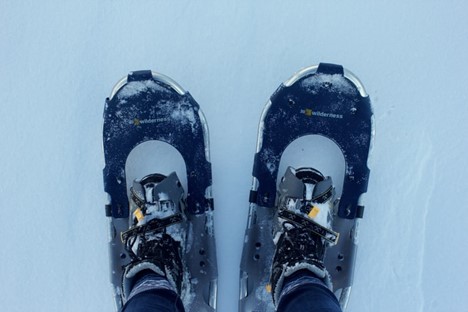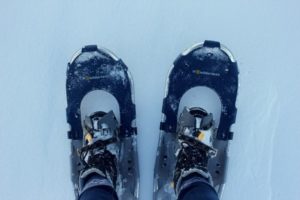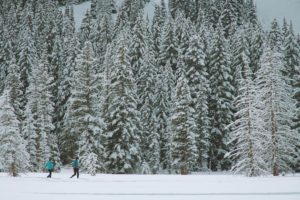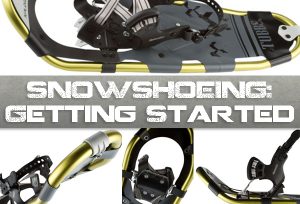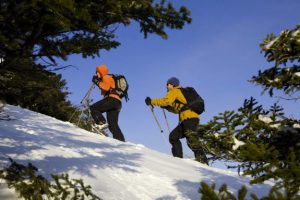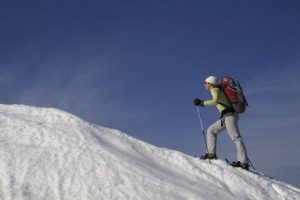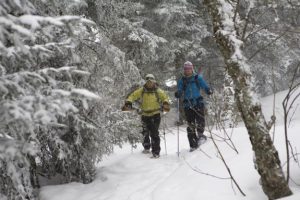Yes, winter is the perfect excuse to stay in and watch movies, but it is also arguably the best time of year to get outside and enjoy nature! When you have proper clothing and the right gear, snow-covered adventures will soon become your favorite. Whether you are looking to get out in your backyard, explore local trails, or are taking a trip to a winter wonderland, snowshoeing is a great way to get outside, get moving, and have fun.
Snowshoes work by distributing your weight on the snow, providing you with the float and maneuverability you need. They also offer great traction for walking on rough, icy, or uphill terrain.
Features of Snowshoes
Frame & Deck
This section floats on the snow and gives the shoe its structured shape.
Decks with a larger surface area will stay on top of the snow better than smaller decks, giving them more flotation, especially in loose, powdery conditions. Because of this, some snowshoers may opt for a bigger deck size for increased support.
Smaller decks, on the other hand, are much easier to maneuver and still offer performance in varying conditions.
Binding
The binding grips your boot to your snowshoe. This can vary across different styles but should be comfortable and fit snug. Bindings provide straps that adjust, connecting you to the small hinging platform that moves as you walk.
If you are looking for the most comfortable and easy to use option, bindings with the BOA system will provide a tight fit and an easy to use closure.
Crampons/Cleats
Below your feet, on the bottom of your snowshoes, crampons or cleats are responsible for providing traction. This will help prevent you from sliding around on snow, gripping icy spots, and even going up rockier areas.
For snowshoers who want to conquer mountains and difficult trails, make sure you have found a pair with quality traction.
For those who are looking to go on leisurely flat snowshoeing trails, you can opt for minimal traction or smaller crampons or cleats on your snowshoes.
Different Types of Snowshoes
Snowshoes come in a variety of styles and designs for different terrain, experience levels, and desires. All snowshoes will have the same core features mentioned above, but depending on where you’d like to go, how experienced you are, your fitness level, and more, you’ll want to select a pair accordingly.
When you have found a pair you love, remember to reference size charts to make sure they will be compatible with and be able to support your weight and shoe size.
Running Snowshoes
If you are looking to maintain your running hobby in the winter, these are for you. Built to be durable, flexible, and lightweight, snowshoes for runners are designed to be used on flat terrain or in tighter packed snow.
Recreational Hiking or Walking
For those who prefer shorter snowshoeing sessions and consider themselves casual enthusiasts. These designs are ideal for walking around trails that are flat or not too strenuous, designed with all the basic elements, varying traction offerings, and preference-based entry methods.
Backcountry Snowshoes – Snowshoes for Skiers and Snowboarders
Skiers, snowboarders, and backcountry snowshoers need a snowshoe that is designed to provide ample float, a reliable binding, lightweight feel, and sturdy traction. These options are meant to tackle steeper mountain trails and difficult terrain. Some options are even built to work with a snowboard boot or larger winter boot.
If you are looking to go snowshoeing in the backcountry or while skiing or snowboarding, invest in a pair that will be reliable for years to come and perform well when you need it.
Snowshoe Entry Systems
When you are looking to invest in a pair of snowshoes, it helps to understand the different types of entry systems.
Some styles have traditional strap systems, where you pull a strap to tighten the bindings on your shoes. There are also designs with a slightly more difficult to get into strapping system, with three straps that go over your foot and one wrapping behind it. Once you are strapped in, this option offers solid support. Other styles are the webbing strap style (uses a nylon webbing-based binding system) and the ratchet style (easy to tighten and release).
An option that is easy to use and growing in popularity is the BOA style, which is best known for its innovative design. By turning a button, a cable tightens evenly throughout the entire binding and heel for a much more secure fit. These bindings also release easily, making these snowshoes one of the most user-friendly styles available on the market today.
Remember, it is important that your snowshoes are built for the type of terrain and activity you have in mind! By choosing an appropriate pair, you will have the best time in the snow.
